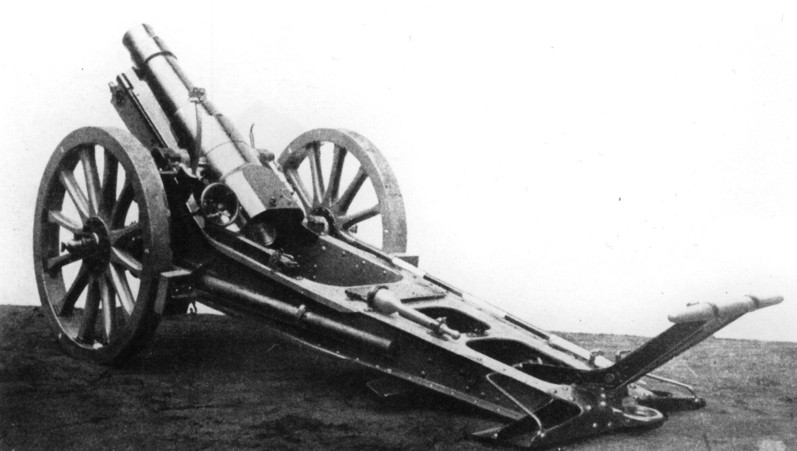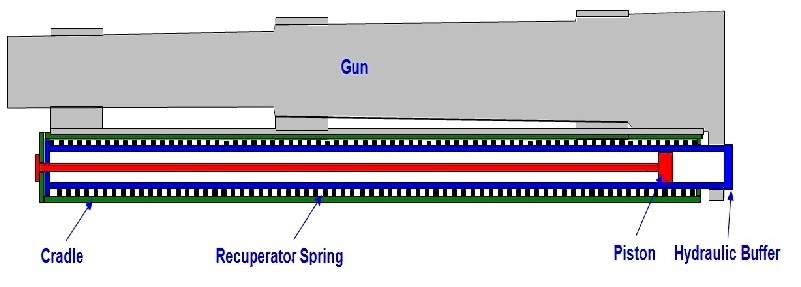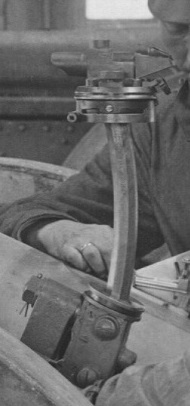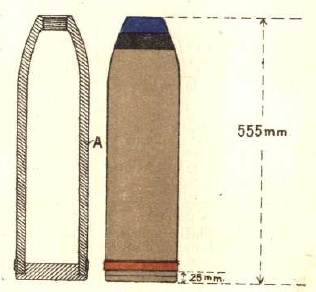Germany introduced the schwere FeldHaubitze (heavy field howitzer or sFH) 93 in 1893 which was designed and built by Krupp to provide the army with a mobile gun capable of firing large shells with plunging trajectories for destroying fortifications. However, because the gun did not have any form of recoil system, it soon became obsolete. Around 1899, Krupp were therefore asked to develop a more modern version of the gun in the form of the Versuchshaubitze (experimental howitzer) VH 99. This incorporated a hydro-spring recoil system but the short recoil length of 340 mm proved to be unsatisfactory and, as a result, the gun was not adopted for service.
Work was then carried out by Krupp to redesign the gun with a longer carriage, a reduced weight and incorporating a long recoil system. The result was the sFH 02 which provided the same maximum range of 7450 m as the VH 99 but was 350 kg lighter and was far more stable when firing. When it was introduced into service in 1902, the sFH 02 was the equivalent of the French Canon de 155 C Mle 1904 TR Ramailho but was superior to the British Ordnance BL 6-Inch 30 Cwt Howitzer whose recoil system was similar to the VH 99. The sFH 02 served throughout WW1 but was largely superseded by the longer range and more numerous versions of the 15 cm sFH 13.

Carriage
The sFH 02 was mounted on a box trail with a gap between the side arms in the front half to provide space for the gun to recoil. The trail was mounted on wooden wheels with brake shoes at the rear that were pulled against each wheel via a chain wrapped around an inner wheel flanged hub. As the gun fired and tried to move backwards on its wheels, this tightened the chain and applied the brakes even harder. The carriage was equipped with a deployable spade to stabilise the gun during firing which could be stowed during transport of the gun. The carriage was not fitted with a gun shield to protect the crew.
The gun cradle was supported by a saddle that was fitted with trunnions and pivoted in bearings at the top front of the carriage. The saddle was fitted with an elevating arc underneath that engaged with a transverse pinion operated via a worm gear by the hand wheel next to the breech. The maximum elevation of the gun was 42 degrees. At the higher elevation angles, it was not possible to load a new shell without lowering the gun first which could only be done using the elevating hand wheel and this significantly slowed down the rate of fire.
The cradle was supported in the saddle on a large diameter pivot that allowed the gun to be traversed by up to 2 degrees in each direction. This was controlled by the front hand wheel that rotated a screw jack at the back of the saddle that moved the rear of the cradle sideways.

The gun was hooked up to a two wheel limber for transport and was light enough to be pulled at slow speed by a team of 6 horses.
Gun Design
The gun was 1.80 m or 12 calibres long with the rifled part of the barrel being 8 calibres or 1.20 m in length. The gun was of built up construction with the jacket shrunk on to the rifled tube and extending for about half of the length of the barrel. A guide tray was attached to the gun to allow it to slide along runners on either side of the top of the cradle during recoil. The front of the tray was attached via a tube shrunk on to the gun and the rear of the tray was attached to projections underneath the jacket and breech.
The jacket was shaped at the rear to support a horizontal sliding breech block of Krupp design. The breech was opened using a single motion lever on the right of the breech that moved the breech block to the right exposing the breech and ejecting any cartridge in the chamber. The breech incorporated an axial striker to fire a loaded cartridge which was fired using a lanyard fitted to the trigger arm on top of the breech (missing from above picture).

Recoil System
The sFH 02 used a relatively simple hydro-spring recoil system mounted within the cradle. This consisted of a hydraulic buffer using a cylinder filled with oil connected to a lug under the breech and therefore recoiled with the gun. The piston within the hydraulic cylinder was mounted on the end of a rod fixed to the front cap of the cradle. The piston incorporated ports that restricted the flow of oil past it during recoil absorbing the recoil energy and bringing the gun to a stop after firing. The maximum recoil length was 0.65 m (26 in).

A recuperator spring was fitted over the hydraulic cylinder with a flange on the front end such that, when the gun recoiled, the spring was compressed between the flange and rear of the cradle running out the gun fully once the recoil had ended.
Sights

The sights were mounted on a bracket arm fixed on the left-hand side at the rear of the cradle as can be seen above. The sights were reciprocating in order to allow them to compensate for the carriage wheels not being level which was the norm – this tilting caused the vertical plane through the gun to be rotated in azimuth away from the centreline of the carriage in the direction of the lowest wheel. If not corrected, this would lead to a large sighting error especially at higher elevation angles. To correct for this effect, the sight mounting arm was fitted with a reciprocating bracket that could be tilted sideways about a pivot that was parallel to the gun axis in order to restore it back into the vertical plane. An adjustment knob was provided for this purpose together with a levelling bubble on the top of the sight.
The sight itself was mounted on the end of a toothed sight arc that could be raised or lowered in the reciprocating bracket. The sight arm was graduated in degrees and metres with a separate scale for each of the different propellant charges used with the gun. In practice, the required tangent elevation for the gun corresponding to a particular range was set on the sight arm and then the gun elevated until the bubble on top of the sight was level.
The main sighting device was a small collimator mounted on a turntable graduated in angular units with a vernier adjustment scale and eyepiece. The sFH 02 was mainly used for indirect fire. In this mode of operation, the target direction was defined relative to an aiming point set up for the gun that could be, for example, a prominent feature on the landscape that could be seen in the sight. The relative bearing was set on the sight and then the gun was traversed until the aiming point could be seen in the sight which then meant the gun was then pointing in the required target direction.
Ammunition

The sFH 02 used separate brass cartridge cases that provided a choice of 6 separate charge sizes depending on the range required. The high explosive shells fired by the sFH 02 evolved over time and both their length and calibre radius head (CRH) changed.
The earlier shells were filled with TNT but when WW1 started, as was the case in the other combatant nations, Amatol started to replace TNT as it was cheaper to manufacture. The Brand Gr. C was an incendiary shell filled with incendiary cylinders that ignited when the shell exploded.
The sFH 02 shells were typically fitted with either the Gr Z 96/04 or G Z. 04 percussion fuzes with the latter providing an optional delay allowing it to penetrate further before detonating.

15 cm schwere Feldhaubitze 02 Specifications
- Length: 4.0 m
- Maximum Width: 1.53 m
- Wheels: Wooden 1.236 m in diameter
- Weight of Gun & Carriage: 2035 kg
- Length of Gun: 1.80 m or 12 calibres
- Bore: 14.97 cm
- Muzzle Velocity: 325 m/s
- Maximum Range: 7,450 m
- Trail: Box trail
- Recoil System: Hydro-spring
- Maximum Recoil: 0.65 m
- Rifling: Polygroove with modified plain section
- Length of Rifling: 8 calibres (1.20 m)
- Twist: Progressive 1 turn in 29.82 to 1 turn in 13.59 calibres
- Grooves: 36
- Firing Method: Percussion
- Elevation: 0° to +42°
- Traverse: -2° left to +2° right
![]()

